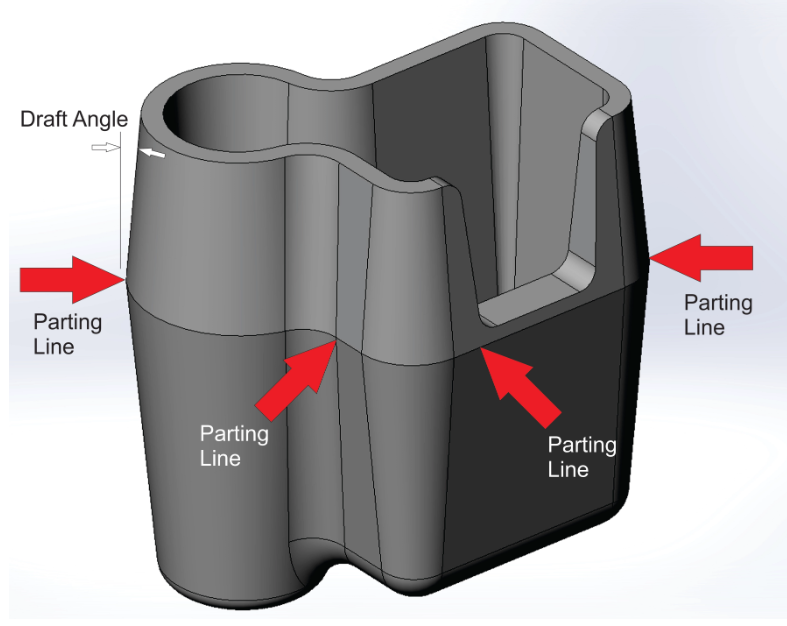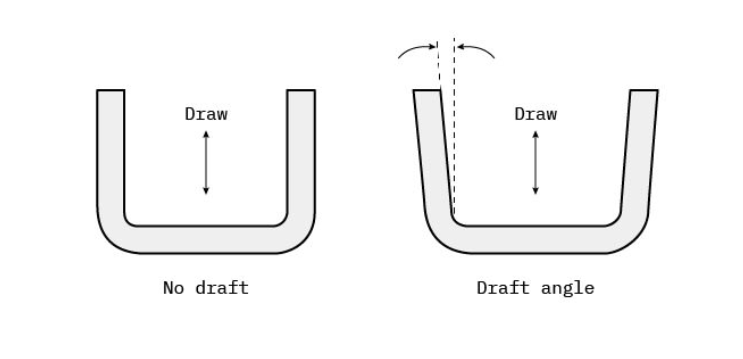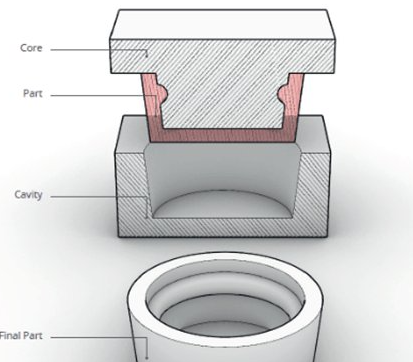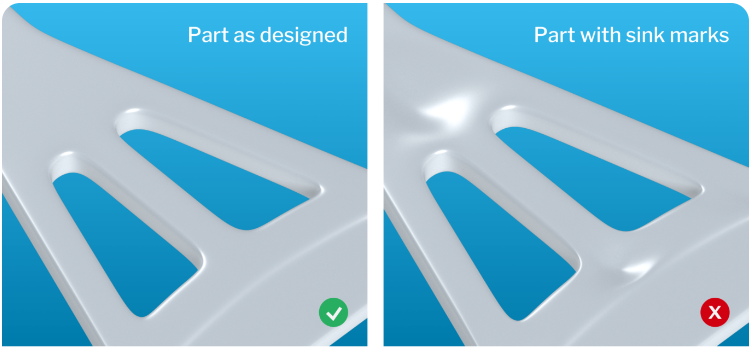Injection moulding is a widely used manufacturing process for producing plastic parts in large quantities. However, it is not as simple as just injecting plastic into a mould and waiting for it to solidify. Several factors need to be considered to ensure that the parts produced are of high quality and consistency. One of these factors is draft angles.

Draft angles are an essential feature of injection moulding design that helps to ensure that the parts produced are of high quality and are easy to release from the mould. In this article, we will cover the definition of draft angles, how they work in injection moulding and the different types of draft angles. We will also discuss the factors to consider when designing draft angles, the effects of draft angles on part quality, and how to minimize these effects.
Understanding Draft Angle in Injection Moulding:
A draft angle is a slight taper that is added to the vertical surfaces of a part. The angle is measured from the vertical surface to the mould parting line. The purpose of adding a draft angle is to enable the part to be easily released from the mould without any damage. When a part is moulded, it shrinks as it cools and solidifies. This shrinkage can cause the part to stick to the mould, making it difficult to release. By adding a draft angle, the part can be easily released as the mould opens.

Draft angles are necessary for injection moulding because they help to prevent damage to the mould and the part during ejection. Without draft angles, the part can get stuck in the mould, leading to damage, and requiring repairs or replacement. This can increase production time and cost. Therefore, designing draft angles is an essential step in the injection moulding process.

.
Types of Draft Angles:
Draft angles refer to the taper applied to the vertical walls of a part to aid in its removal from a mould. Some types of draft angles include:
Positive draft angle: the walls of the part taper outward, away from the parting line of the mould.

Negative draft angle: the walls of the part taper inward, towards the parting line of the mould

Zero draft angle: the walls of the part are perpendicular to the parting line of the mould.
Variable draft angle: the draft angle varies along the length of the part to accommodate different moulding requirements.
Side core draft angle: a draft angle is added to the side cores of a mould to allow them to release from the part more easily.


How do you design better draft angles?
Draft angles are important in the design of parts that will be injection-moulded or die-cast, as they help to facilitate the release of the part from the mould. To design better draft angles, it is important to consider several technical details.
Most Parts Need Draft Angles between 1 to 2 Degrees
Determine the minimum draft angle required for the manufacturing process. Most injection moulding or die-casting processes require a draft angle of 1-2 degrees. However, the draft angle can vary based on part geometry, material, and surface finish.
Keep the draft angle consistent across the part. The draft angle should be uniform on all sides of the part, including the parting line. Avoid variations in draft angles, as this can lead to non-uniform shrinkage and deformation of the part.
An Average Extra Degree for Every Inch of Depth
Use a minimum of 1 degree per inch (2.5 cm) of depth. As the part depth increases, the required draft angle also increases. Using a minimum of 1 degree per inch (2.5 cm) of depth ensures that the part can be easily ejected from the mould.
Additional Draft angle For complex Features:
Add additional draft angles for complex features. Sharp corners, deep recesses, or intricate details may require additional draft angles to ensure proper release from the mould. Consider these features when determining the necessary draft angle.
Materials Selection:
The type of material used for the part can affect the required draft angle. Softer materials may require a larger draft angle to ensure proper release from the mould, while harder materials may require a smaller draft angle. The specific characteristics of the material, such as shrinkage and thermal expansion, should also be considered when determining the draft angle.

Avoid negative drafts.
A negative draft, also known as an undercut, occurs when a feature on the part prevents the part from being released from the mould. Avoid negative draft features, or design the mould to include additional sliders or lifters to facilitate part ejection.
Textured Parts Need More Drafts
For some complex geometries and surfaces, the injection moulded part design consists of specific texture and shapes. For these surfaces, special arrangements are required. An optimal practice used for these is the draft angle must be added to the optimal 1.5 to 2 degrees in such parts. The addition is done at a rate of 1.5 degrees per 0.001 inch of surface depth.
Product Testing Before bulk production:
Create a prototype or 3D model to test the draft angle and ensure proper release from the mould. Adjust the draft angle as needed to achieve the best possible outcome.
Surface finish requirements:
The surface finish of the part can also affect the required draft angle. A higher gloss finish may require a larger draft angle to ensure proper ejection, as the mould release agent may not be as effective on a glossy surface. Additionally, textured or embossed surfaces may require additional draft angles to ensure proper release from the mould.

Overall, designing better draft angles requires careful consideration of manufacturing requirements, part function, location of the parting line, surface finish, and testing to ensure the best possible outcome. It is important to consult with a professional injection moulding company to determine the best draft angle for a specific part.
Baichuan is a leading injection moulding parts manufacturer, based in China. Our skilled engineers and machinists are always available for cutting-edge services, from individual conceptual design to bulk production. So, if you require a hassle-free manufacturing service with high precision and durability, kindly call us at www.bccncmilling.com for a quick quote on your project.
Poor Draft Angle Effects on Part Quality:
Draft angles can affect part quality in several ways.
Warping:
As the part cools and solidifies, it can shrink unevenly, leading to warping or distortion. Draft angles can help to reduce the risk of warping by allowing the part to release from the mould easily.

Sink Marks:
Sink marks occur when the part cools and solidifies faster on the surface than in the centre. This can lead to a depression or sink mark on the surface of the part. Draft angles can help to reduce the risk of sink marks by allowing the part to cool and solidify uniformly.

Finishing:
Draft angles can also affect the appearance of the part. If the draft angle is too large, it can cause a step or mark on the surface of the part. This can reduce the aesthetic appeal of the part, and it may require additional finishing steps.

Design Tips for Improving Mould Release and Reducing Warping
In addition to the factors to consider when designing draft angles, there are several design tips that can improve mould release and reduce warping.
- First, it is important to ensure that the part is symmetrical. If the part is asymmetrical, the shrinkage may be uneven, leading to warping.
- Second, it is recommended to use fillets or radii instead of sharp corners. Sharp corners can cause stress concentrations, leading to warping or cracking.
- Third, it is important to avoid thick and thin areas in the part. Thick areas will shrink more than thin areas, leading to warping.
- Another design tip is to use uniform wall thickness throughout the part. Uneven wall thickness can lead to differential shrinkage, causing warping or distortion. In addition, it is recommended to use a ribbed design instead of a thick wall to improve the stiffness of the part. Ribs help to distribute the load evenly, reducing the risk of warping.
Conclusion
Summing things up, the importance of considering draft angles in the design process cannot be overstated. By incorporating draft angles into the design of the part and the mould, it is possible to produce high-quality parts efficiently and cost-effectively. The use of proper draft angles can help to minimize production time, reduce production costs, and ensure that the parts produced are of high quality and consistency. Therefore, designers and manufacturers of injection-moulded parts should take the time to carefully consider draft angles in the design process.
At Baichuan we are having experienced engineers and designers that ensure your product’s precision and durability. We have over 20 years of field experience with state-of-the-art modern machining set-up. We are always behind our products until you are satisfied.


